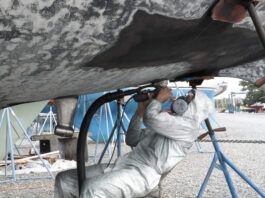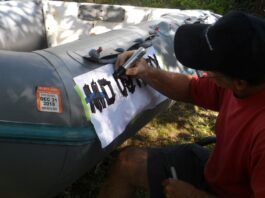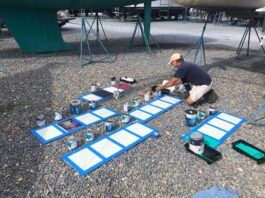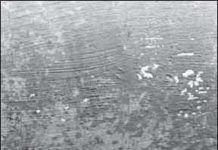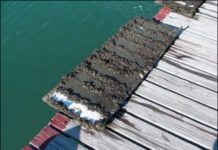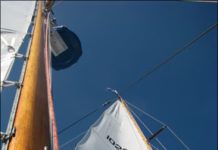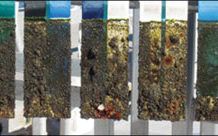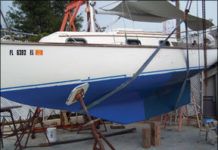It Takes a Tough Sailor to Make a Smooth Boat Bottom
Fairing in through hull fittings, as described in the February issue, will go a long way toward reducing bottom drag in light air, but it won't really do the job unless the paint surface of the bottom is smooth. A surprisingly high percentage of boats not used primarily for racing have bottom paint jobs that range from poor to atrocious. If your bottom has peeling patches that haven't been in, brush marks from failure to smooth out thick bottom paints, or stipple marks from application with a roller, your boat will be slower in light air than it could be. Bottom paints, unlike topside paints, are not formulated for smooth application, in most cases. They have a high solids content and quick-flashing solvents, a combination guaranteed to make smooth application difficult. Even the racing boat with the smoothest bottom didn't start out that way.
Antifouling Test 18-month Checkup
The latest report on our ongoing bottom paint tests, this look at Practical Sailor's antifouling test panels includes 65 hard and ablative paints that have been submerged for 18 months. The test paints include those from Blue Water Paints, Epaints, Flexdel, Interlux, Pettit, Sea Hawk, West Marine, and Copper Coat. An experimental stick-on paint, BoatKote Laminate, was also tested. Some copper-laden perennial favorites again topped the ratings, but some eco-friendly antifoulants from Epaints also did surprisingly well. The report also compares the results of PS's long-term bottom paint test to those of a test conducted by the San Diego Unified Port District and funded by the Environmental Protection Agency. San Diego's “Final Report on Safer Alternatives to Copper Alternatives in Antifouling Paints for Marine Vessels” evaluated how well certain alternative antifouling paints (with limited or no harmful biocides) performed.
Professional Advice for Do It Yourself Boat Blister Repairs
Earlier this year, reader and occasional contributor Fred Hatch found himself facing a quandary common among boat owners. The topsides of his 32-foot sloop were well faded, and small blisters were beginning to show along the waterline. Would he be in for an ambitious haulout and big yard fees, or might there be other remedies?
Sparkling Brightwork: Careful Attention to the Details
It takes practice to produce a perfect, mirror finish on varnished wood, but it is not so much a difficult task as an exacting one, where attention to detail and no short cuts are the secrets to success. Whether you are finishing new wood, refinishing old wood, or maintaining a finish in good condition, the basics are the same.
Upgrading the C&C 33 Part II
For hull bottom and topside repair, we love our Porter-Cable random orbit sander and WEST System Microlight Fairing Compound.
PS Advisor: A Classic Finish for a Classic Boat
I’m the happy owner of a 31-foot sloop, a replica of a 100-year-old wooden Friendship. Her fiberglass hull was laid up in a mold made from the old boat. My boat is very traditional, with wooden mast and spars, and lots of heavy bronze hardware on her gaff rig. The mast and spars all need to be stripped and refinished this off-season, and the owner of the yard where she’s stored has recommended using Mas epoxy (www.masepoxies.com) as the base, then a coat of varnish, then a sprayed-on clear coat. The Mas people advised not to use an oil or mineral-based spar varnish, as it isn’t compatible with their product.
Boat Maintenance: 18-month Checkup on Wood Finishes Test
Testers rated dozens of wood finishes—including one-part varnishes, two-part varnishes, synthetic systems, and teak oils—after the test panels faced a year and a half of Florida weather exposure. Find out how the finishes ranked for ease of application, gloss, appearance, and durability. Still going strong in the ongoing long-term test are 20 of the original 22 one-part varnishes and all six of the original two-part varnishes. As a group, varnish alternatives such as Interlux Sikkens Cetol, teak oils, and teak sealers struggled to make the 18-month cut, but nine remain in the test. Products that were doing well 18 months after application include coatings from Interlux, Coelan, Pettit, HMG, and Nautiking. The report also includes a brief look at a new product, Vermont Natural Coatings PolyWhey, which was applied to PS's Cape Dory 25 test boat. This unique coating's base is whey, a byproduct of cheesemaking, rather than oil.
Mailport: December 2010
Letters to the Practical Sailor editors in December 2010 include: paint colors, sailmaker services, bilge pumps, pest control and the Wirie v. a DIY WiFi antenna.
Mailport: November 2010
Letters to Practical Sailor from our readers. November 2010's topics include cleaning products, sail hardware, galley stoves and anti-fouling paints.
Marine Maintenance: Bottom Paint Test Results
In the interest of saving readers both time and money, Practical Sailor recently inspected six different sets of antifouling test paints that had been submerged for varying amounts of time in the waters of Florida and New England. Each fiberglass panel set was painted with more than five-dozen different bottom paints, including ablative antifoulings, hard paints, freshwater paints, eco-friendly bottom paints, and copper-free paints. This seasons report-we offer these in-depth looks at antifouling twice a year-reinforces what weve stated before: Most modern paints designed for salt water are effective against hard growth for 12 months, but some are clearly better slime fighters. Test paints included formulas from Interlux, Pettit Paints, Blue Water Marine, BoatKoat Laminates, Coppercoat, Sea Hawk, Epaint, Flexdel, and West Marine. The report breaks it down by performance, price, and niche so readers can decide which paint best suits their needs.


































